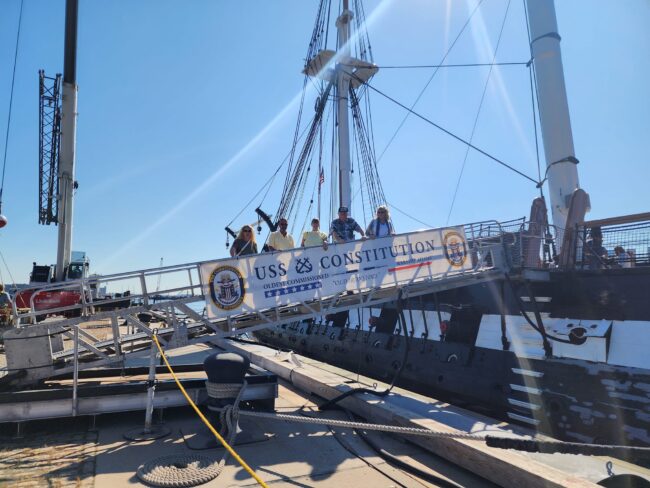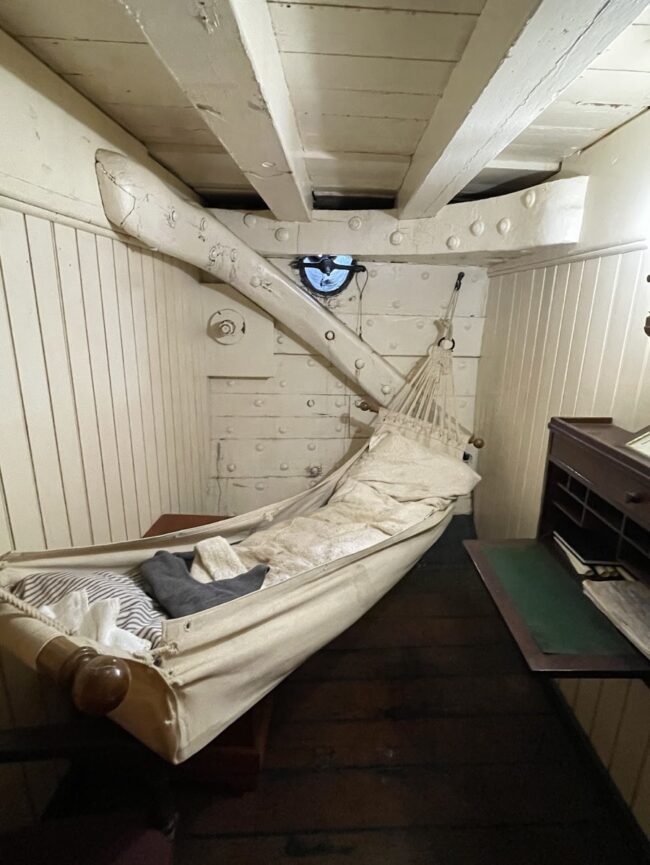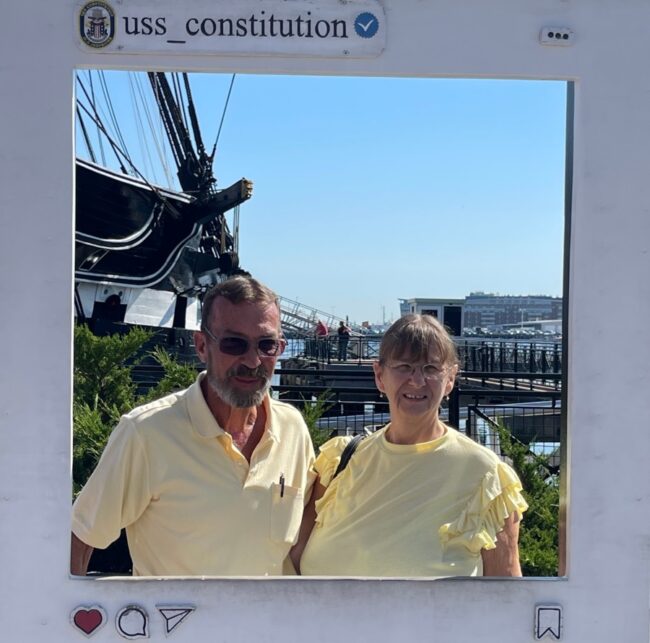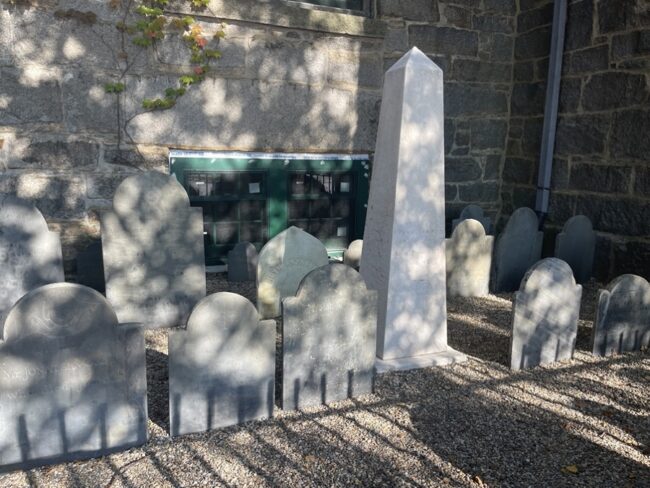Estimated reading time: 8 minutes

We had breakfast at the bed and breakfast this morning, which was fantastic. After finishing our meal at 9:50 a.m., we headed to Colleen’s place. The B&B is now decorated for Halloween with a “Hocus Pocus” theme. There are Binx’s everywhere.
Where does a ghost go on vacation? Mali-boo!

Breakfast was superb!
Today, we go south to Boston to visit the USS Constitution. It is about an hour’s drive.
Colleen drove Jon’s SUV so all six of us could fit in. We had a great time with two sets of parents teasing the kids; they didn’t have a chance!
The USS Constitution Museum is in the Charlestown Navy Yard, part of the Boston National Historical Park in Boston. The museum is near the USS Constitution ship at the end of Boston’s Freedom Trail.
As we walked toward the museum, the USS Constitution came into view. They were maintaining the center mast and had a crane to remove the yardarms. The structure had to be very strong as the sails weighed over 2,000 pounds!
Why did the ghost starch his sheet? He wanted everyone scared stiff.

The oldest commissioned ship on the USN USS Constitution. The USS Constitution, built between 1794 and 1797, is estimated to have 8-10% original material remaining, according to the Naval History & Heritage Command Detachment Boston.
The weather was perfect, with a temperature of 80 degrees and clear skies. Taking pictures was easy.
Getting to the museum was quite a hike but well worth the effort.

We were walking to the ship!
Up we go for our visit to the ship! Thanks to Mark for the photo-op!

Come on, Mark! We need you as a tour guide!
We will send a copy of this picture to the Captain of the Emerald Princess. That poor Captain only had a small joystick to drive his 125,000-ton displacement ship! A wheel like this on his bridge would be an excellent addition.

It has a wheel!
The business end of the ship was interesting. The Constitution was rated a 44-gun frigate, but she often carried over 50 guns. During the War of 1812, she mounted twenty-four 32-pound carronades on the spar deck, a long 18-pound “chase” gun forward and thirty 24-pound long guns on the gun deck.
The 24-pounder long gun was a heavy caliber piece of artillery mounted on the Age of Sail warships. 24-pounders were in service in France, Spain, Great Britain, the Netherlands, Sweden, and the United States navies. The cannons could reach a mile but were inaccurate at that distance, so most battles were fought with the ships close together.
It took nine sailors to operate a single cannon; normally, thirty cannons were on the gun deck and fourteen on the top deck. The ship had a crew of 450 men!

Mighty armaments
Why are vampires easily fooled? They’re suckers.
The cannons had various types of ammunition, including grappling hooks for tearing down canvas and rigging, anti-personnel shells, cluster bombs, and the ability to toss flammable liquids to set enemy ships on fire.

They had quite a choice of items to shoot out of the cannons!
The Captain’s quarters were impressive for the timeframe. He used this location to plan battles, meet with his staff, and direct them.
That’s Cuba, Mark’s mother in the mirror!

The Captains quarters
The officers had a place to store their valuables in the safest place on the ship! It was also used to keep unruly wenches!

Lock her up!
The crew has smaller sleeping quarters, with hammocks that sway with the ship, making it easier to clean the floors.

The hammocks swayed with the motion of the boat.
The bilge pumps were interesting as they were manually operated. The bilge area collects any wastewater or fluids that come from the ship. It also gathers condensation that drips inside the hull, and water leaks from other sources. It has to be pumped out and overboard using these manually operated pumps.
The waste was run across the floor and into the sea, making for a horrible smell when in operation.

Manually powered bilge pumps!
The senior officers were given a small private area with a hammock, writing desk, and storage space.

Officers cabins.
The masts are foremast: 198 ft (60 m), mainmast: 220 ft (67 m), and mizzenmast: 172.5 ft (52.6 m). They are anchored on the ship’s keel and run through the decks supported by massive beams.
America’s embryonic navy, which included the USS Constitution and several other frigates, was fashioned in part from a remarkable species of wood called southern live oak. A dense wood that weighed as much as 75 pounds per cubic foot, live oak was solid and resistant to rot and salt air.

The main mast goes through the lower decks and 135 feet into the air.
We went down two decks filled with guns and room for storage and sailors to sleep. The third deck down was not open to the public (I think it was the quarters for the naval crewmen to stay while they were pulling duty).

What? No escalator?
We were framed!

Rick and Cuba joined us.

Colleen and Mark.
I found reading all the posted material to be quite enlightening.

For a 225-year-old ship, it was pretty interesting.
Next stop, Salem, Massachusetts. We had lunch on the way and the 911 Lounge. It was pretty good.
Between February of 1692 and May of 1693, over 150 people were accused, and 25 were killed. Everyone tends to get the gist of the story: mass hysteria caused people to wildly accuse one another, eventually condemning the city’s women. However, there are misconceptions regarding the Salem Witch Trials and parts of the story that are not often told.

Mass hysteria is underway!
The city of Salem ran a public competition to design the Salem Witch Trials Memorial, and it was officially dedicated in 1992 on the 300th anniversary of the trials.
Located just off Charter Street, on Liberty Street, is Salem’s simple yet dramatic memorial to the 20 victims of the witch trials of 1692. Four-foot high granite walls surround three sides, with granite benches representing each victim cantilevered inward from the wall.
Etched on each bench is a name, means of execution, and execution date. On the stone threshold of the memorial, one can read the words of the accused taken directly from court transcripts.
Visitors will note that the words – “God knows I am innocent” – are cut off in mid-sentence, representing lives cut short and indifference to the protestations of innocence.


Salem has a load of graves.
We saw a 45-minute presentation about the trials, which we found very enlightening.

The museum was fascinating.
After the show, we headed for home to rest up! Tomorrow, we will finally rest and visit the family for lunch and dinner; we have been on the go now for days!

